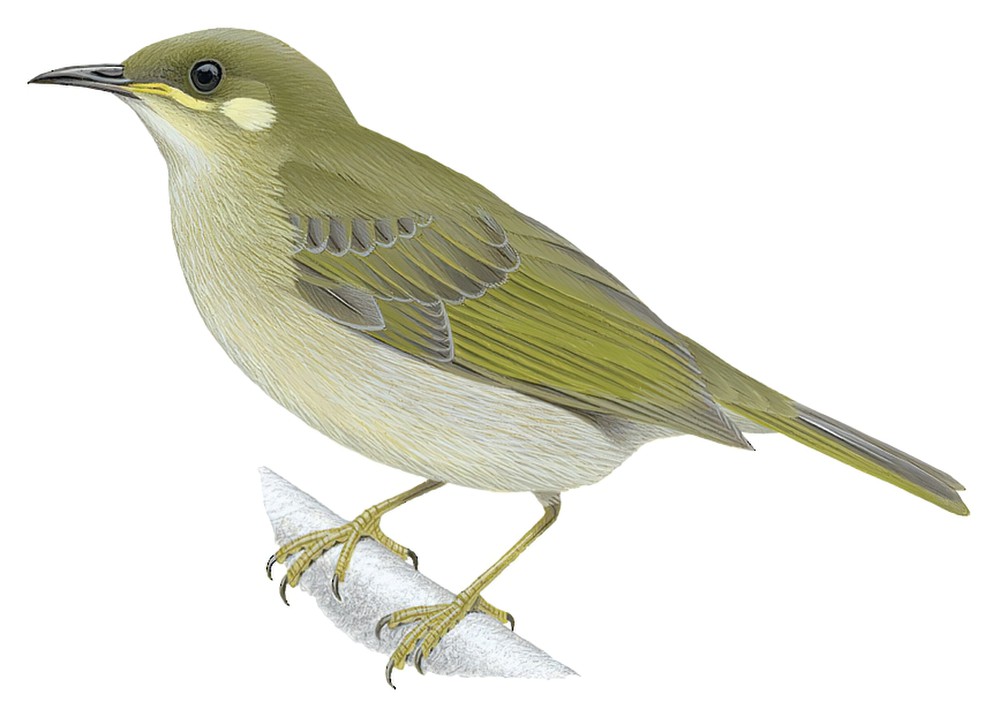Yellow-gaped Honeyeater / Meliphaga flavirictus

Yellow-gaped Honeyeater
SCI Name:
Protonym: Ptilotis flavirictus Ann.Mus.Civ.Stor.Nat.Genova 16 p.76
Taxonomy: Passeriformes / Meliphagidae / Meliphaga
Taxonomy Code: yeghon1
Type Locality: Fly River, southern New Guinea.
Author: Salvadori
Publish Year: 1880
IUCN Status: Least Concern
DEFINITIONS
MELIPHAGA
(Meliphagidae; Ϯ Lewin's Honeyeater M. lewinii) Gr. μελι meli, μελιτος melitos honey; -φαγος -phago -eating < φαγειν phagein to eat; "OR. PICÆ. GEN. MELIPHAGA. CHARACTER OF THE GENUS. BEAK arched, stout, and almost three-sided, Pl. 3. b. NOSTRILS long, and covered with a membrane. TONGUE long, and split into a number of hairs at the end, Pl. 3. a. FEET formed for climbing, the outer toe joined to the middle one, as far as the first joint. The birds of this genus feed on the nectarine juice, concentrated in all the flowers of this country, which they extract with the bunch of hair at the end of their long tongues. Meliphaga Phrygia. Pl. 3. WARTY-FACED HONEYSUCKER. ... Meliphaga Cyanops. Pl. 4. BLUE-CHEEKED HONEYSUCKER. ... Meliphaga Chrysotis. Pl. 5. YELLOW-EARED HONEYSUCKER. ... Meliphaga Chrysocephala. Pl. 6. GOLDEN-CROWNED HONEYSUCKER." (Lewin 1808); "Meliphaga Lewin, 1808, Birds New Holland, p. 4 and pl. 5. Type, by subsequent designation (G. R. Gray, 1840, List Genera Birds, ed. 1, p. 15), Meliphaga chrysotis Lewin = Ptilotis lewinii Swainson." (Salomonsen in Peters 1967, XII, 364).
Var. Melliphaga, Miliphaga, Chelliphaga.
Synon. Dorothina, Ptilotina, Ptilotis.
● (syn. Anthochaera Ϯ Regent Honeyeater A. phrygia) "MELIPHAGA b, Lewin, (1808). Zanthomyza, Swains. (1837). Merops, Lath. Philemon, Vieill. Anthochæra, V. and H. Xanthomyza, Strickl. (1841). Philedon, 3rd div. Cuv. (1817). 2nd div. Cuv. (1829). M. phrygia, (Lath.) Lew. B. of N. H., pl. 3 ... b On examining Lewin's work for the purpose of ascertaining the proper type of his genus Meliphaga, I unfortunately, for my former edition, looked at the one published in 1822, where he placed his short characters on the page in which he described his M. chrysotis, so that I considered that species to be the type. But I have since consulted the original edition of 1808, where I find that he established the genus on his M. phrygia, as he not only gave generic characters on the same page with the specific description of that bird, but also figured the bill and tongue of that species in illustration of his genus. It must therefore, if we "ought always to retain the original name for that part of the old genus which was considered typical by its author," be kept as the type of the genus Meliphaga of Lewin, as established in 1808. The C. novæ hollandiæ, as proposed by Vigors and Dr. Horsfield for the type of Meliphaga, is not even noticed by Lewin in his work, and cannot therefore on any principle be regarded as the type of his genus" (G. Gray 1841); "Meliphaga G. R. Gray, 1841, List Gen. Birds, ed. 2, p. 20. Type, by original designation, Merops phrygius Shaw. Not Meliphaga Lewin, 1808." (Salomonsen in Peters 1967, XII, 436).
● (syn. Phylidonyris Ϯ New Holland Honeyeater P. novaehollandiae) "Genus. MELIPHAGA*. Lewin et Auct. ... *The species of the family of Meliphagidæ appear very numerous, and every arrival from New Holland and the Australian islands brings an addition to their number. At the same time the species themselves are but ill-defined; and in the present imperfect state of our knowledge , and while information is daily increasing, we consider it unadviseable to attempt more than a rude sketch of this interesting family. The group which we have selected above as representing the Meliphaga of Lewin and Authors, is the only assemblage of these birds of which we can speak with any satisfaction to ourselves. The species accord in their general characters; and in their habits and the structure of their tongue they are represented as agreeing most perfectly. They exhibit five prominent modifications of form, according to the variation chiefly of the characters of the bill and tail. At present we wish to consider these types of form as sections only of the group, which we name provisionally the genus Meliphaga. When the species become more known, the present sections may justly be considered genera, and the higher group may be denominated the subfamily Meliphagina. When this subdivision takes place, the section which stands first in our text may be considered the true Meliphaga. The Mel. Novæ Hollandiæ will form the type." (Vigors & Horsfield 1827); "MELIPHAGA NOVÆ-HOLLANDIÆ, Vig. and Horsf. New Holland Honey-eater. ... I QUITE agree with Messrs. Vigors and Horsfield in making the bird forming the subject of the present Plate [vol. IV, pl. 23] the type of the restricted genus Meliphaga. Independently of its claim to this distinction from the circumstances of its being the oldest known, it is the species to which the generic term is especially applicable, since, I conceive, it feeds less upon insects and more upon nectarine juices than any other of the family." (Gould 1843); "Meliphaga Vigors and Horsfield, 1827, Trans. Linn. Soc. London, 15, p. 311. Type, by original designation, Certhia novaeHollandiae Latham. Not Meliphaga Lewin, 1808 (Meliphagidae)." (Salomonsen in Peters 1967, XII, 425).
flavirictus
L. flavus yellow, golden-yellow; rictus gaping jaws, open mouth < ringori to show the teeth.
SUBSPECIES
Yellow-gaped Honeyeater (crockettorum)
SCI Name: Meliphaga flavirictus crockettorum
crockettorum
Frederick E. Crockett (1907-1979) and his wife Charis Denison Crockett (b. 1905) US explorers, organised expedition to the South Seas and New Guinea 1937-1938 (subsp. Microptilotis flavirictus).
Yellow-gaped Honeyeater (flavirictus)
SCI Name: Meliphaga flavirictus flavirictus
flavirictus
L. flavus yellow, golden-yellow; rictus gaping jaws, open mouth < ringori to show the teeth.
UPPERCASE: current genus
Uppercase first letter: generic synonym
● and ● See: generic homonyms
lowercase: species and subspecies
●: early names, variants, mispellings
‡: extinct
†: type species
Gr.: ancient Greek
L.: Latin
<: derived from
syn: synonym of
/: separates historical and modern geographic names
ex: based on
TL: type locality
OD: original diagnosis (genus) or original description (species)












